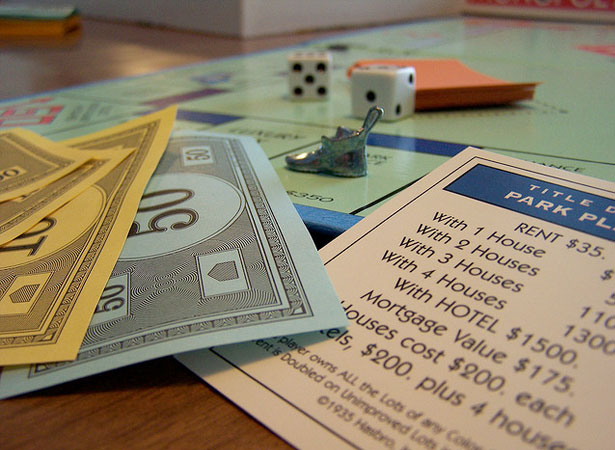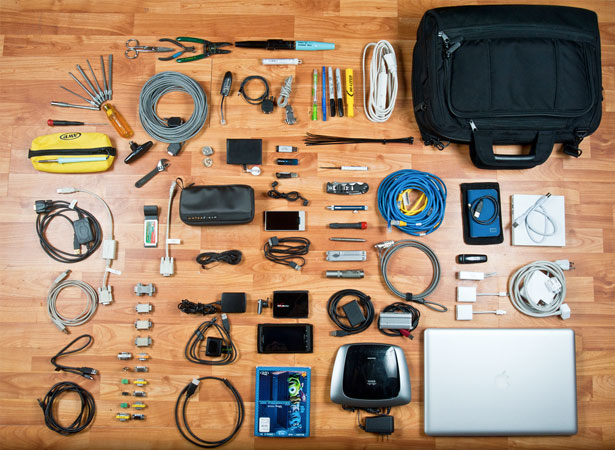 All freelance designers and developers eventually have to face these ultimate questions; "How much should I charge for my services? Should I charge by the hour, or by the project?"
And then, once that question is answered, of course, the question becomes, "How can I charge more?"
As opposed to a traditional job, in which you are paid a set rate based on what your boss, or your company, is willing to pay you, determining freelance pricing can be tricky.
As services such as design and development are rather abstract terms to most, and as the internet is still a relatively new medium, freelancers are left to wade through the muck in order to figure out their own worth.
All freelance designers and developers eventually have to face these ultimate questions; "How much should I charge for my services? Should I charge by the hour, or by the project?"
And then, once that question is answered, of course, the question becomes, "How can I charge more?"
As opposed to a traditional job, in which you are paid a set rate based on what your boss, or your company, is willing to pay you, determining freelance pricing can be tricky.
As services such as design and development are rather abstract terms to most, and as the internet is still a relatively new medium, freelancers are left to wade through the muck in order to figure out their own worth.
"Take charge of your value. Don't let someone else choose it for you."
You get what you pay for
 At the end of the day, the simple answer to the question of what you should charge for service is this: whatever clients are willing to pay. This is the same principle that works with any business model. It is the same principle that determines how much comic books and baseball cards are worth, and it is the same principle that determines the salary of someone who working in waste management, as opposed to a doctor.
For example, you may have a very rare baseball card, and it may be listed at a very high price on an index, but if the demand for that card does not exist, you simply will not get the listed price for it. Conversely, while waste management is a very important service, when someone is in a life or death situation, they depend on a doctor more than the guy who drives the garbage truck. Thus, the doctor earns more.
At the end of the day, the simple answer to the question of what you should charge for service is this: whatever clients are willing to pay. This is the same principle that works with any business model. It is the same principle that determines how much comic books and baseball cards are worth, and it is the same principle that determines the salary of someone who working in waste management, as opposed to a doctor.
For example, you may have a very rare baseball card, and it may be listed at a very high price on an index, but if the demand for that card does not exist, you simply will not get the listed price for it. Conversely, while waste management is a very important service, when someone is in a life or death situation, they depend on a doctor more than the guy who drives the garbage truck. Thus, the doctor earns more.
"For every promise, there is price to pay." - Jim Rohn
Understanding how to set prices
 With that said, the first thing you should do in determining how to charge more is to determine what you currently charge, and why. Factors like your profit margin (costs versus profits), your skill level and experience, as well as the current market demand all can determine what you can get away with in your prices. And remember, these factors are not designed to scam people. These factors are realistic measures of what and why you can charge what you can.
For instance, if the market demand is high, meaning more people want your service than can provide it, you can get away with higher prices. However, if the market is saturated with design professionals, you will need to tailor your prices to remain competitive in a crowded marketplace. Also, the experience factor allows you to sell yourself at a higher rate, as you will be looked upon as more reliable, and less prone to mistakes.
While that may not seem fair, and while you may be a new designer with incredible skills, it is simply human nature to want someone who has experience. You would not want to visit a surgeon performing his first surgery, would you? Much the same, companies would rather pay more to hire an experienced design or development professional.
With that said, the first thing you should do in determining how to charge more is to determine what you currently charge, and why. Factors like your profit margin (costs versus profits), your skill level and experience, as well as the current market demand all can determine what you can get away with in your prices. And remember, these factors are not designed to scam people. These factors are realistic measures of what and why you can charge what you can.
For instance, if the market demand is high, meaning more people want your service than can provide it, you can get away with higher prices. However, if the market is saturated with design professionals, you will need to tailor your prices to remain competitive in a crowded marketplace. Also, the experience factor allows you to sell yourself at a higher rate, as you will be looked upon as more reliable, and less prone to mistakes.
While that may not seem fair, and while you may be a new designer with incredible skills, it is simply human nature to want someone who has experience. You would not want to visit a surgeon performing his first surgery, would you? Much the same, companies would rather pay more to hire an experienced design or development professional.
"The moment you make a mistake in pricing, you're eating into your reputation or your profits." - Katharine Paine
Know your client
 One other important factor in determining your prices is your client. When dealing with individuals, charging hundreds or thousands of dollars can seem a bit much. For an individual person to drop five grand on a fully integrated blog design seems excessive. Then again, when working with a company, this amount seems like a drop in the bucket compared to the hundreds of thousands they may be making each year.
This needs to be kept in mind when determining prices. Many freelancers will start out doing business with individuals or small companies. This can be good in order to practice, build your skills, as well as build a portfolio that can be used later to attract larger clients, and of course, charge more.
One other important factor in determining your prices is your client. When dealing with individuals, charging hundreds or thousands of dollars can seem a bit much. For an individual person to drop five grand on a fully integrated blog design seems excessive. Then again, when working with a company, this amount seems like a drop in the bucket compared to the hundreds of thousands they may be making each year.
This needs to be kept in mind when determining prices. Many freelancers will start out doing business with individuals or small companies. This can be good in order to practice, build your skills, as well as build a portfolio that can be used later to attract larger clients, and of course, charge more.
"You have got to know your customer better than they know themselves." - Stephen Little
Selling yourself is the key
 Regardless, when it comes to charging more, one of the key factors is to sell yourself, as well as sell your skills. Many freelance designers and developers forgo selling themselves for fear of rejection, and instead, they rely on the marketplace to determine their worth. This tactic leads to design professionals actually underselling themselves.
You need to keep in mind that, as a freelancer, it is your job to design and develop, but it is also your job to convince potential customers to hire you, and pay your prices, over your corporate competition.
Regardless, when it comes to charging more, one of the key factors is to sell yourself, as well as sell your skills. Many freelance designers and developers forgo selling themselves for fear of rejection, and instead, they rely on the marketplace to determine their worth. This tactic leads to design professionals actually underselling themselves.
You need to keep in mind that, as a freelancer, it is your job to design and develop, but it is also your job to convince potential customers to hire you, and pay your prices, over your corporate competition.
"Your most important sale is to sell yourself to yourself."
Build value into your prices
 There are a number of ways to achieve this. First, consider that people place more value on expensive things, even if they are the same as less expensive versions. An example of this is found in prescription and over the counter drugs. When comparing generics to brand names, the exact same medication, in the exact same form, regulated by the same government agencies, and in the exact same amount is found.
However, most people have been conditioned to believe that a brand name is best because companies charge more for it. The same is true with freelancing. Do not undersell yourself. Be confident in your pricing and do not waver.
Negotiating is fine if you feel like it, but be proud of your work and stand by your prices. Potential customers will not only respect you more for doing so, but they will also place the added value on your service. Of course, with that said, you must remain reasonable. If corporate design firms and other freelancers are only charging a fraction of your prices, you need to reevaluate your approach. Don't be afraid to test the waters.
There are a number of ways to achieve this. First, consider that people place more value on expensive things, even if they are the same as less expensive versions. An example of this is found in prescription and over the counter drugs. When comparing generics to brand names, the exact same medication, in the exact same form, regulated by the same government agencies, and in the exact same amount is found.
However, most people have been conditioned to believe that a brand name is best because companies charge more for it. The same is true with freelancing. Do not undersell yourself. Be confident in your pricing and do not waver.
Negotiating is fine if you feel like it, but be proud of your work and stand by your prices. Potential customers will not only respect you more for doing so, but they will also place the added value on your service. Of course, with that said, you must remain reasonable. If corporate design firms and other freelancers are only charging a fraction of your prices, you need to reevaluate your approach. Don't be afraid to test the waters.
"Price is what you pay. Value is what you get." - Warren Buffett
Charging more by doing less
 Another way to charge more is to have various service levels, and then sell those to potential customers. The key to doing this is much the same as any other business that offers multiple service levels: you use the old "but wait, there's more" tactic. In infomercials, salespeople offer products at a specific price.
At first you might think, that's a reasonable price for that product. But then, they explain that, if you act now, you get not one, but two of the same product for the same price. Suddenly, you think, wow, what a deal. Little did you know, the company still paid less for the two products they are selling than what you are paying.
The same is true in up-selling your design and development services. Let's say, based on your costs, your base price is $1,000 for XHTML, simple graphic design, and customer's CMS customization. But, when you tell the customer your price, you may want to simply explain that you charge $1,000 for XHTML. If they seem interested, you could pull the "Wait, there's more!" routine, and explain that you could throw in CMS customization and graphic design for $500 more.
By doing this, you are still getting your original asking price for what you would have charged anyway, but now you are getting an extra $500 in the process, and the customer thinks they are getting a great deal. And, if the customer seems to flounder at this offering, you could tell them you will cut them a deal and do the job for $1,000.
This way, you still get your asking price, but you come out looking like the good guy who is doing the client a favor, meaning more work for you in the future, as well as possible referrals.
Another way to charge more is to have various service levels, and then sell those to potential customers. The key to doing this is much the same as any other business that offers multiple service levels: you use the old "but wait, there's more" tactic. In infomercials, salespeople offer products at a specific price.
At first you might think, that's a reasonable price for that product. But then, they explain that, if you act now, you get not one, but two of the same product for the same price. Suddenly, you think, wow, what a deal. Little did you know, the company still paid less for the two products they are selling than what you are paying.
The same is true in up-selling your design and development services. Let's say, based on your costs, your base price is $1,000 for XHTML, simple graphic design, and customer's CMS customization. But, when you tell the customer your price, you may want to simply explain that you charge $1,000 for XHTML. If they seem interested, you could pull the "Wait, there's more!" routine, and explain that you could throw in CMS customization and graphic design for $500 more.
By doing this, you are still getting your original asking price for what you would have charged anyway, but now you are getting an extra $500 in the process, and the customer thinks they are getting a great deal. And, if the customer seems to flounder at this offering, you could tell them you will cut them a deal and do the job for $1,000.
This way, you still get your asking price, but you come out looking like the good guy who is doing the client a favor, meaning more work for you in the future, as well as possible referrals.
"There are two kinds of people, those that work to try to charge more and those that work to do less."
Lay it all on the line
 Finally, you can simply lay everything out for the potential client. Many people who are searching for design and development services do not understand what is involved in getting a site started, let alone what goes into designing and developing one. This means that you need to educate them as to the costs of individual services.
Explaining each individual cost, from domain name and hosting costs, all the way up to logo design costs, helps the client to understand why your prices are set where they are. This should typically be looked at as a last ditch effort, and you need to take care not to appear desperate when doing this.
The purpose of doing this is not to plead your case, but to confidently explain what the customer needs. It will be harder to balk at a freelancer who charges more when faced with the reality of the costs of building a site. Again, many people do not understand everything involved, so by educating them, you may be able to sell more services, while earning their gratitude by treating them with respect.
Finally, you can simply lay everything out for the potential client. Many people who are searching for design and development services do not understand what is involved in getting a site started, let alone what goes into designing and developing one. This means that you need to educate them as to the costs of individual services.
Explaining each individual cost, from domain name and hosting costs, all the way up to logo design costs, helps the client to understand why your prices are set where they are. This should typically be looked at as a last ditch effort, and you need to take care not to appear desperate when doing this.
The purpose of doing this is not to plead your case, but to confidently explain what the customer needs. It will be harder to balk at a freelancer who charges more when faced with the reality of the costs of building a site. Again, many people do not understand everything involved, so by educating them, you may be able to sell more services, while earning their gratitude by treating them with respect.
"Do what you do so well that they will want to see it again and bring their friends." - Walt Disney
What prices do you charge?
In the end, again, the number one rule for charging more for your services is that clients will only pay what the market says your services are worth. You can try every trick in the book, but if the market dictates a certain price range, you are almost always locked into that. Don't get absurd with your prices, and you should be able to sell more in no time. Remember, selling yourself is the biggest factor in having clients pay more for your services. Create a need, and then fill that need. Let the customer feel like they are getting a great deal, even if you are charging the same price you would charge for less work. Finally, treat each client with respect. Respecting a client goes a long way in gaining future business, as well as in getting referrals, and the more work you get, the more experience you have, meaning you can charge more in the future. So, ask yourself: are my prices reasonable? Am I truly living up to the value of my skills? What should I be doing, right now, to upsell my services to current and future clients? Am I using all the tools at my disposal to charge more?Aidan Huang
Aidan Huang is a self-taught developer, designer and blogger. He is also the editor-in-chief at Onextrapixel. Follow him on Twitter @AidanOXP
Read Next
15 Best New Fonts, July 2024
Welcome to our monthly roundup of the best fonts we’ve found online in the last four weeks. This month, there are fewer…
By Ben Moss
20 Best New Websites, July 2024
Welcome to July’s round up of websites to inspire you. This month’s collection ranges from the most stripped-back…
Top 7 WordPress Plugins for 2024: Enhance Your Site's Performance
WordPress is a hands-down favorite of website designers and developers. Renowned for its flexibility and ease of use,…
By WDD Staff
Exciting New Tools for Designers, July 2024
Welcome to this July’s collection of tools, gathered from around the web over the past month. We hope you’ll find…
3 Essential Design Trends, July 2024
Add some summer sizzle to your design projects with trendy website elements. Learn what's trending and how to use these…
15 Best New Fonts, June 2024
Welcome to our roundup of the best new fonts we’ve found online in the last month. This month, there are notably fewer…
By Ben Moss
20 Best New Websites, June 2024
Arranging content in an easily accessible way is the backbone of any user-friendly website. A good website will present…
Exciting New Tools for Designers, June 2024
In this month’s roundup of the best tools for web designers and developers, we’ll explore a range of new and noteworthy…
3 Essential Design Trends, June 2024
Summer is off to a fun start with some highly dramatic website design trends showing up in projects. Let's dive in!
15 Best New Fonts, May 2024
In this month’s edition, there are lots of historically-inspired typefaces, more of the growing trend for French…
By Ben Moss
How to Reduce The Carbon Footprint of Your Website
On average, a web page produces 4.61 grams of CO2 for every page view; for whole sites, that amounts to hundreds of KG…
By Simon Sterne
20 Best New Websites, May 2024
Welcome to May’s compilation of the best sites on the web. This month we’re focused on color for younger humans,…














